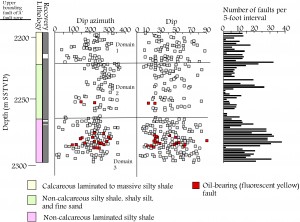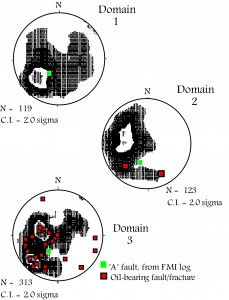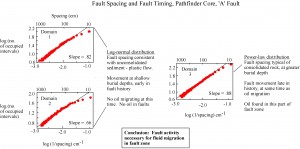S. Losh, 1998, AAPG Bull. v 82, pp. 1694-1710
Petroleum reservoirs at South Eugene Island are trapped against the ‘A’ Fault (Figure 1), indicating it has very low lateral permeability. At the same time, the fault is probably the major conduit of hydrocarbon from source kitchens or secondary accumulations into their present reservoirs, requiring elevated lateral (and vertical) permeability. What is the nature and rate of fluid flow in the fault?
Figure 1. Structure contour map on top of OI1 sand, South Eugene Island Blocks 330, 331, and 338, about 90 miles offshore Louisiana. Minibasin-bounding growth fault (‘A’ Fault zone and ‘Antithetic Fault’) are shown in gray; location of Pathfinder (A20ST2) and A6ST wells are shown.
To test the idea that the fault transmits fluids to the reservoirs at rates fast enough to produce oil economically directly from the fault, the DOE-funded Pathfinder well intentionally intersected the fault in shale so that any oil that we obtained would be intrinsic to the fault. In the past, deep, large-diameter (4-inch) shale coring in the Gulf of Mexico was notoriously difficult due to the tendency of the clay minerals to adhere to the coring bit and reduce drill penetration rates to near zero, a phenomenon known as “balling.” With a team of experts from oil and service companies, we developed a coring protocol centered on an experimental drilling mud that was anticipated to eliminate “balling.” The equipment and mud performed extremely well, resulting in collection of about 350 feet of 4-inch diameter core at penetration rates up to nearly 100 times the industry average at the time, with 95% recovery of the core. A sample of the core, showing a fault and an oil-stained sand (both fluorescent yellow on right) is shown in Figure 2.
Figure 2. Section of Pathfinder well core, 7901 – 7902 ft SSTVD: ordinary light (left) and shortwave UV ligh(right). The interval shown is mostly shale, with siderite nodules. An oil-stained sand is near the base of the photo, and an oil-stained, slickensided fault transects the photo from upper left to lower right. The 350-foot core consists of three subequal lithologic domains: upper massive calcareous silty shale with sparse sand laminae, middle non-calcareous shaly silt with sand beds, and lower laminated to massive non-calcareous silty shale with sand laminae. Over 400 faults were logged. They are particularly abundant in the upper and lower domains. All sands in the 350-foot core are oil-stained (fluorescent yellow), but only faults in the lower 1/3 of the core, mostly in the lower lithologic domain, contain oil. Oil was present throughout the cored interval, but “saw” the faults in the upper 2/3 of the core as no more permeable than the shale. Why?
Detailed logging of the core showed that it consisted of three lithologic/structural domains (Figure 3). The entire core was in calcareous to non-calcareous silty shale with variable abundance of sand laminae. Each domain is somewhat different from the others lithologically, but the main difference is in the structural character. The upper two domains contain widely-spaced faults that, with only two exceptions (out of hundreds of faults), do not contain hydrocarbons and are structurally simple (Figure 4). The deepest, third domain contains more closely-spaced faults, many of which contain hydrocarbons, and shows greater structural complexity.
Figure 3. Fault log from Pathfinder well core, showing variations in fault spacing, orientation, and hydrocarbon content. Three domains are identified on the basis of lithology and, primarily, structural differences.
Figure 4. Lower-hemisphere Kamb contour plots of fault dip/dip azimuth measurements, Pathfinder Well core (software from Rick Allmendinger, Cornell Univ). Oil-filled faults do not show affinity for any specific orientation, and show no simple relation to known principal stress orientations. This lack of direct relationship to stress field indicates that hydraulic fracturing (perpendicular to minimum compressive stress, which is oriented NE-SW in Block 330 (Peska and Zoback, 1995 Jour. Pet. Tech.) was not a factor in oil migration in the fault zone.
Fault spacing in rocks is known in many geologic settings to be described by power-law statistics. Spacing in unconsolidated to semi-consolidated sediment is not well-studied, but is probably not power-law owing to cooperation of brittle failure, particulate flow, and other deformation mechanisms.
Plots of the spacing between adjacent faults in the core (a 1-D traverse) against the number of spaces of that size that is occupied by at least one fault (a way of representing fault spacing) are shown below in Figure 5. A log-log plot of these parameters should be linear for power-law statistics. However, the plots for the upper two domains (Domains 1 and 2 in Figure 5), whose faults do not contain oil, are curved. Only the plot for the lower domain (Domain 3), where the oil-bearing faults are found, is linear. The faults in the third domain appear to have behaved differently, from a mechanical point of view, from the faults in the rest of the core. They deformed as competent rock, not as unconsolidated sediment. The faults in the rest of the core deformed as unconsolidated sediment, presumably early in their burial history.
Figure 5. Plots of interval size (log 1/spacing) vs. frequency of occupied intervals for each of the three lithologic domains in the Pathfinder core.
This conclusion is corroborated by very high calcite d18O values (up to 30.9 permil SMOW) obtained from a thick gouge zone that forms the boundary between Domains 1 and 2. This high d18O indicates near-seafloor temperatures of calcite precipitation in the fault (about 9 C). These low temperatures are further evidence of the shallow burial depth, hence early timing, of movement on these faults
Oil is known to have migrated relatively recently at SEI 330. Only the faults in Domain 3 were active at or near present burial depths, after sediment had become consolidated enough to behave as competent rock in terms of fault spacing. The restriction of oil to those recently- or presently-active faults strongly indicates that the flow of oil was controlled by activity of the fault zone. The oil did not “see” the inactive faults in the remainder of the core: mere presence of faults is not enough to produce flow in the fault zone.
The lack of oil in faults in the upper two domains where oil is present in sands indicates that, to the oil, faults and fractures effectively had the same permeability as unfaulted silty shale. Fluid pressure in the fault was never high enough to enhance fracture permeability during oil migration, regardless of the fracture’s orientation with respect to principal stress axes. Although fault permeability is known from laboratory work to be enhanced at low effective stress, the restriction of oil migration to that portion of the fault that was active at the time indicates that effective stress in the fault was never low enough to enhance flow throughout the fault. Hydrocarbon flow in the fault requires that fracture permeability be enhanced by another mechanism: active slip.





